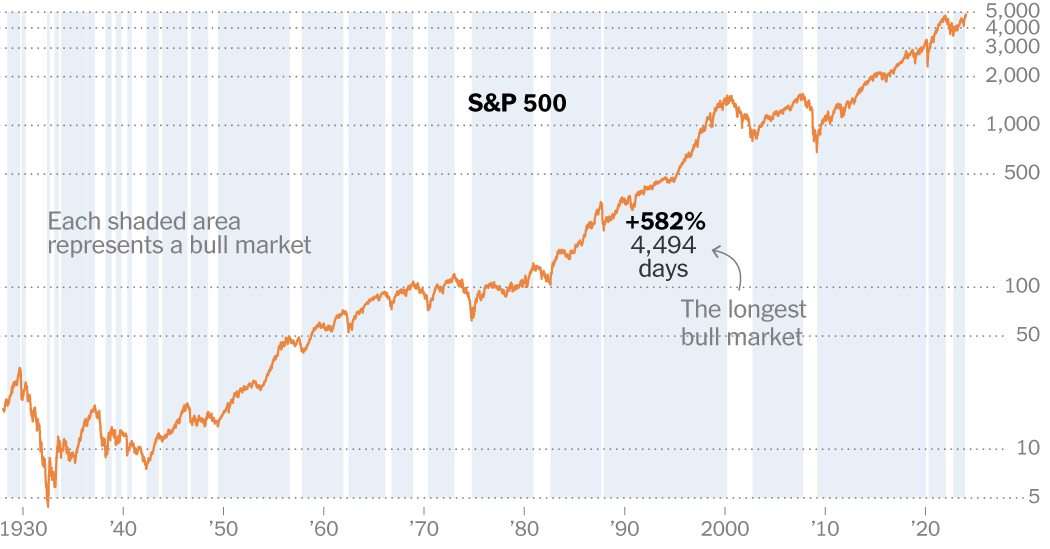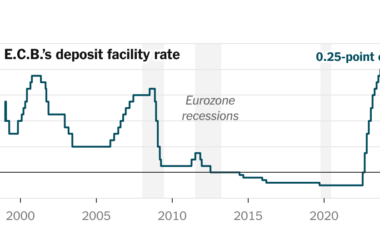The S&P 500 index closed at a record on Friday, crossing above its old high-water mark, set in early 2022. The gains show that investors have overcome fears of rising interest rates and panic about a recession that had governed stock trading for much of the past two years.
Instead, they’re now betting that a drop in rates will help expand corporate profits, while the economy stays on a relatively solid footing.
Even though the S&P 500 had struggled to push into the record — having bumped up against it for weeks before finally crossing above with jump on Friday — the record high should also put an end to a debate on Wall Street about whether the recent run-up in shares reflected a lasting shift in sentiment, or if it was just a rebound that would fade as fear over the outlook for the economy returned.
For the average person, it does not matter what label analysts are applying to the stock market when it is heading higher, but with the new high, they will be hearing a lot more about the “bull market.”
Here’s what to know about the market now.
What makes this a bull market?
“Bull market” isn’t an official designation. There is no governing body that says what it is, or decides when it started (as there is with a recession). But on Wall Street, there are two common ways the label gets applied.
One says a bull market is confirmed when a major index like the S&P 500 climbs 20 percent above its most recent low. By that standard, the bull market was confirmed in June, when the S&P 500 closed 20 percent above its October 2022 low.
But some people were quick to dismiss the standard as too easy for the market to meet. They use the second definition for a bull market, in which stocks have to rise past their old high.
As of Friday, by both measures, the S&P 500 is in the midst of a bull market.
When did the bull market start?
The current bull market started in October 2022, when the S&P 500 reached its most recent low. Since then, the index has swelled about 35 percent.
How long do bull markets last?
A bull market can last more than a decade or a few months. Stocks are in a bull market more often than not.
The previous bull market lasted less than two years, starting in March 2020 and ending in January 2022. Before that, stocks were in a bull market that lasted nearly a decade, from March 2009 amid the Great Recession to February 2020, as Covid-19 emerged as a global threat.
When was the last S&P 500 record?
The index hit a record on Jan. 3, 2022, the first day of trading that year. Low interest rates and high consumer spending, fueled by stimulus checks and the rollout of the coronavirus vaccines, helped bolster it.
“There was a euphoria surrounding what we were tasting as postpandemic life,” said John Lynch, chief investment officer for Comerica Wealth Management.
But just days later, the Federal Reserve released details of a meeting that suggested the central bank was worried about inflation and would start raising rates to slow the economy. The index ended that week about 2.5 percent lower, the start of a bumpy decline that continued until October, when stocks were 27 percent below the January peak.
The Fed began its rate-increase campaign in March 2022, which raised the cost of borrowing for companies and consumers. Worried about a recession, investors dumped stocks as the Fed progressively raised rates from near zero to a range of 5.25 to 5.5 percent, the highest in 22 years.
Then data began to point toward a cooling labor market, and inflation began to moderate. Investors started to bet that the Fed was nearly done with its campaign, and once the central bank signaled that it was considering lowering rates in 2024, the drop reversed and stocks rallied past that old high.
What does a bull market mean for ordinary investors?
Maybe nothing. Certainly the fact that stocks are climbing is good news for those with a 401(k) retirement plan, and even better news for people who have large investments in the stock market (often higher-income Americans).
But the record should not change most investors’ behavior, said Mark Wilson, a financial adviser at MILE Wealth Management in Irvine, Calif. Mr. Wilson advises his clients not to make decisions based on day-to-day news in financial markets, he said. Often news that the stock market is high will set off fears that it is bound to drop.
“People picture the stock market like a heart monitor that goes up and goes down, so some get nervous,” Mr. Wilson said. Although the stock market has hiccups and does not break records every day, it generally trends up over time, he added.
For people investing for the long term, Mr. Wilson said, what is important is the value of their assets when they need the cash. Plus, it is important to recognize that the S&P 500 is just one index; a pension or retirement plan will invest money across asset classes that may not all be up at the same time.
What does this mean for the economy?
Higher share prices can encourage companies to expand, and for the 60 percent of Americans who own stocks, a bull market means they might feel slightly wealthier because their long-term savings are worth more. That might make them feel better about their finances, but what is more likely to make them spend more is the size of their paychecks, according to Rupert Watson, an economist at Mercer, an asset manager.
“The most important thing for people on average incomes is whether they have a job and whether their wage is going up,” he said.
What would end the bull market?
A bull market ends when stocks fall 20 percent below their last high — a period known as a bear market.
The last time the S&P 500 entered a bear market was in 2022, as investors recoiled in the face of stubborn inflation and rising interest rates.
But even if stocks do not fall that far, they could get knocked back some.
Inflation is moderating, but some analysts warn that it is too early to declare victory. Prices rose 3.4 percent on a yearly basis in December, down from a 9.1 percent peak in 2022 but still higher than the Federal Reserve’s 2 percent target.
If inflation trends unexpectedly go in the wrong direction, the Fed may not cut rates as soon as investors are hoping.
“The single most important thing that could reverse the rally is inflation not coming down,” Mr. Watson said.


